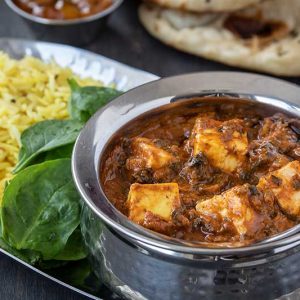The modern-day British curry. A quintessential takeout or impressionistic homage to its South Asian roots?
Steeped in a past of imperialism, spice trading and merchant sailors, the historical identity of this popular British food is complex, not least in the fact its name is an anglicised catch-all for Indian cuisine.
So where to begin in our exploration of this nationally-adored food?
Who is responsible for introducing the Brits to the Indian palate, and how did the UK’s menu of curries evolve from the archaic tastes which define the Asian subcontinent’s culinary fare?
A saga of spice
Probe to the core of South Asian cookery and you will find spices, a lot of them, and some so old, they outdate the beginning of the Roman empire by a gargantuan two and half thousand years.
Pinning the use of ginger and turmeric in Indian cooking back to 2500 BC, two archaeologists revealed in 2013 how they had discovered the ingredients within fragmented cooking pots and human teeth, taken from the ancient archeological site of Farmana.
Utilising a method of identifying plant residue called starch grain analysis, archaeologists Arunima Kashyap and Steve Weber were able to distinguish a connection between modern and 4,500 year-old recipes through the presence of spice.
With such aged roots entrenching the use of numerous spices in Indian cooking, it is no wonder many find the basic jars of curry powder and curry paste which frequent Britain’s supermarket shelves to be so reductive.
“Walk into a grocery store in India and you find that the singular curry powder does not exist, neither as material nor idea. In India, we use endless varieties of spice mixes instead,” wrote Sucharita Kanjilal in Quartz India.
Whilst it’s fair to say the Brits have not entirely mastered the intricate art of Indian food, our acquaintance with spices does surprisingly date back to the age of the Crusades in the 11th century.
Yet it wasn’t until the end of the 15th century that demand for spices in the West really boomed following Portuguese explorer Vasco da Gama’s forgery of a new trading route from Europe to South East Asia.
Demonstrating this sudden desire for spice, authors of The Road to Vindaloo David Burnett and Helen Saberi note the rising popularity for spiced food in Britain at the end of 16th century, evident particularly in London’s thriving Eastern spice market.
But this now readily available crop came with a high cost.
Harvested in tropical terrain and shipped nearly 5,000 miles across the planet, the value of spices was astronomical, the price increasing with every hand that sold them on.
According to Jack Turner, author of Spice: The History of a Temptation, the price of spice had inflated 1,000 percent by the time they reached the markets of Venice, Bruges, and London.
Nowadays though, the likes of turmeric, cumin, ginger, cardamom and more are omnipresent in Western supermarket aisles.
The trick is how to use them.
Brief history of British curry
Etymology
Copied from Portuguese colonisers of India and adopted into the English language, the word curry is not recognised by any of India’s official languages or 1600 dialects.
Originating from the Tamil word ‘kaṟi’ or ‘கறி’, curry is as nonspecific as gravy or sauce, author of 600 Curries, Raghavan Iyer outlined. In many countries, curry was a word to simplify what colonisers saw as foreign cuisine.
Patrick West outlines, the word is as much a generalisation of Indian cuisine as pasta is an oversimplification of tagliatelle or spaghetti.
Terminology aside for now though, let us uncover how curries became such a favourite with the British public.
Seafarers
Established in 1600, the British East India Company was founded to transport cargoes of goods from the Indian subcontinent to Britain.
Over 250 years later, the Company had collapsed and Britain had turned to exporting vast quantities of tea from India and Bangladesh for profit.
Travelling across these tea trading routes, sailors from the city of Sylhet in Bangladesh arrived in London at cheap guest houses, eating spiced stews in the places which were to become today’s curry houses.
Nowadays, approximately 90 percent of current curry venues in Britain are owned and managed by descendants of the Sylheti seafarers.
Glasse and Mahomed
Using fowl or rabbit, Hannah Glasse’s book ‘The Art of Cookery Made Plain & Easy’ was the first curry recipe to be published in Britain. Distributed in 1747, the first edition contained three Indian pilau recipes.
Very different from the tikka masala and saag aloo recipes popular in the UK today, Glasse’s recipe stewed the aforementioned game meats with peppercorns, coriander seeds, onions, butter and water.
It wasn’t until 26 years later though that curry was included on a British menu in 1773, at the Norris Street Coffee House, London.
Soon after, the cuisine became a regular speciality in the capital’s Piccadilly and in 1810, Bengali entrepreneur and traveller Sake Dean Mahomed opened Britain’s first, exclusively Indian restaurant.
Situated in Mayfair, the Hindoostane Coffee House was Mahomed’s plan to capitalize on the nation’s growing love of spicy food and appeal to both the British people and Indian aristocracy.
Unfortunately, Mahomed’s business venture went bankrupt in 1812, failing to entice the Indian aristocracy who had cooks serving more authentic meals at home.
Still, despite his loss, Mahomed is remembered as the UK’s founding father of modern curry restaurants.
Birmingham and the balti
Concocted in the mid ‘70s as a means of creating a lighter, healthier curry, the Birmingham balti was invented by the Pakistani and Kashmiri communities in the southeastern area of the city.
Requiring all the meat to be off the bone and the chefs to use vegetable oil instead of ghee, the bali is made in a thin, pressed steel wok which heats up very quickly.
Meaning bucket in Urdu, the word balti refers to the deep utensil it is cooked and served in. Traditionally, the meal is served with naan to scoop up the delicious sauce.
Just three miles outside Birmingham’s city centre, the Balti Triangle is a flavour-fuelled hub of Asian food and where the balti was born.
Find an official Birmingham balti recipe below!
Traditional Birmingham balti recipe
(Courtesy of The Birmingham Balti Co.)
Balti sauce ingredients
- 3x Tablespoons of Vegetable Oil
- 4x Chopped Onions
- 2cm length piece of peeled and grated fresh ginger
- l large crushed and peeled garlic clove
- 1 teaspoon The Birmingham Balti Garam Masala
- 1 teaspoon paprika
- 1 teaspoon turmeric
- 1 teaspoon ground coriander
- 1tsp chilli powder
- 1 large grated tomato
- 1 teaspoon of salt
- Handful of chopped coriander
- 300ml water
Balti sauce method
- Heat the oil in a large pan over a moderate heat then add the onions, ginger and garlic, stirring regularly until onions are translucent.
- Add the tomato and stir into the mixture, then add the water and all the other ingredients.
- Give it all a good stir and bring to the boil.
- Cover and simmer on low heat for 30 minutes.
- Allow to cool completely then blitz in a food processor until smooth.
Balti chicken recipe for one person
Ingredients
- 6 tbsp balti curry sauce or Base gravy
- 3 tbsp Vegetable oil
- 1 grated tomato
- 2 small finely chopped onions
- 2 diced chicken breasts (dice in smallish pieces to ensure speedy cooking)
- 2 small chopped chillies (take the seeds out if you prefer a milder taste)
- 1 tsp of ginger paste
- 1 tsp of garlic paste
- 2 pinch of salt
- 1 tablespoon of The Birmingham Balti Garam Masala
- 4 teaspoons of The Birmingham Balti spice pot blend OR 1 tsp ground Paprika, 1tsp dried fenugreek leaves, 1 tsp ground cumin and 1 tsp ground turmeric.
- Water
- Fresh coriander to garnish
Method
- Heat oil in a balti bowl until sizzling.
- Add chopped onion and tomato and cook until onions are translucent.
- Add ginger, garlic purees, chillies and give it a quick stir, then add in 4 teaspoons of balti spice blend or individual spices and stir, adding a splash of water.
- Add chicken, cook for a few moments then add 1 tablespoon of Garam Masala and 2 pinches of salt.
- When the chicken is nearly cooked add in 6 tablespoons of your balti sauce.
- Garnish with fresh coriander and serve with Naan bread.
-
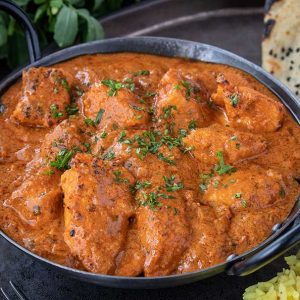 Chicken Tikka Masala£5.25 – £17.85
Chicken Tikka Masala£5.25 – £17.85 -
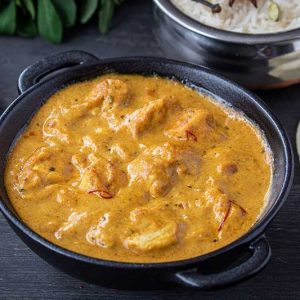 Chicken Saffron Korma£5.25 – £8.90
Chicken Saffron Korma£5.25 – £8.90 -
 Chicken & Roasted Vegetable Jalfrezi£5.25 – £8.90
Chicken & Roasted Vegetable Jalfrezi£5.25 – £8.90 -
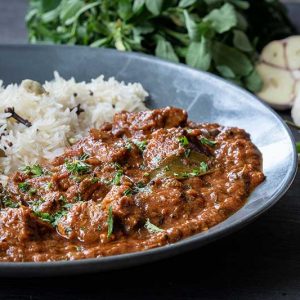 Garlic Chilli Beef Madras£5.75 – £10.35
Garlic Chilli Beef Madras£5.75 – £10.35 -
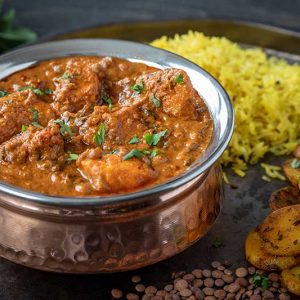 Murgh Makhani (Butter Chicken)£5.25 – £8.90
Murgh Makhani (Butter Chicken)£5.25 – £8.90 -
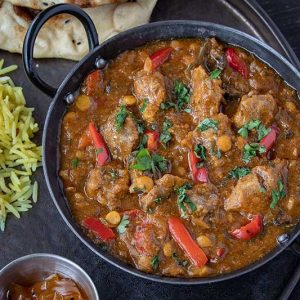 Lamb Dhansak£5.75 – £10.35
Lamb Dhansak£5.75 – £10.35 -
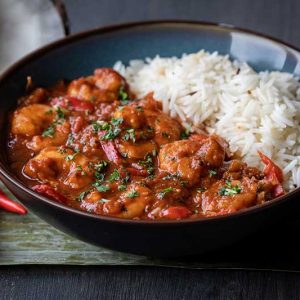 Goan Style Piri Piri Prawn Curry£5.75 – £10.35
Goan Style Piri Piri Prawn Curry£5.75 – £10.35 -
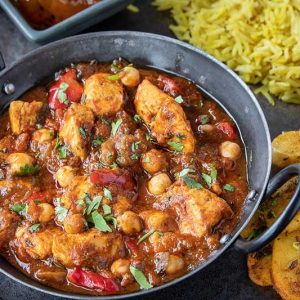 Chicken Achari£5.25 – £8.90
Chicken Achari£5.25 – £8.90 -
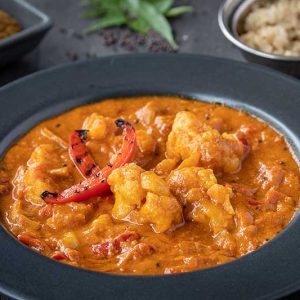 Keralan Red Pepper & Cauliflower Curry£5.25 – £8.90
Keralan Red Pepper & Cauliflower Curry£5.25 – £8.90

